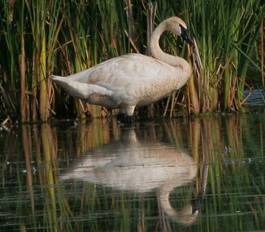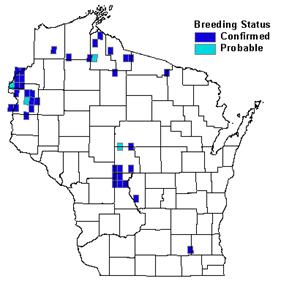Photo by Scott Franke


Status/Protection
- Global Rank: G4 Key to global and state ranks
- State Rank: S3B
- WBCI Priority: SGCN, State Endangered
Population Information
The Federal BBS information can be obtained at http://www.mbr-pwrc.usgs.gov/bbs/bbs.html by clicking on Trend Estimates and selecting the species in question. All estimates are for time period (1966-2005).
- Federal Breeding Bird Survey: N/A
- Federal Breeding Bird Survey (WI): N/A
- Federal Breeding Bird Survey (BCR 23): N/A
- Federal Breeding Bird Survey (BCR 12): N/A
- WSO Checklist Project: N/A
Life History
- Breeding Range: Scattered localities throughout western Canada and northern U.S.
- Breeding Habitat: Emergent Marsh, Northern Sedge Meadow and Marsh, Southern Sedge Meadow and Marsh, Open Bog-Muskeg, Inland Open Water, and Wild Rice.
- Nest: Mound of sedges, cattail tubers, and other emergent vegetation surrounded by water; may be built on top of muskrat or beaver lodges (Mitchell 1994).
- Nesting Dates: Eggs: early May to late June (Hartman and Mossman 2006).
- Foraging: Dabbles (Ehrlich et al. 1988).
- Migrant Status: Short-distance migrant; some small populations are resident.
- Habitat use during Migration: Inland Open Water, Great Lakes Open Water, Wild Rice, Emergent Marsh, and Open Bog-Muskeg.
- Arrival Dates: Late March to early May (Robbins 1991).
- Departure Dates: Early November (Robbins 1991).
- Winter Range: Midwestern flocks migrate to Minnesota, Wisconsin, Iowa, e. Kansas, se. S Dakota, e. Nebraska, n.-central and ne. Oklahoma, central Texas, n. Arkansas, Missouri, w. Kentucky, w. Tennessee, w. Illinois, and Virginia.
- Winter Habitat: Freshwater springs, streams, rivers, ponds, lakes and reservoirs. Also forages in pastures, cropland and estuaries.
Habitat Selection
The Trumpeter Swan nests in large, shallow (<1 m) wetlands containing a wide variety of emergent, submergent, and floating vegetation, such as sago pondweed, water milfoil, arrowhead, bur-reed, bulrush sedges, and wild rice (Matteson et al. 1986, Mitchell 1994). Nesting territories are generally located in areas of low human disturbance and range in size from 2.5 to 60 hectares. Shrubby or emergent plants suitable for escape cover and abundant loafing sites also are important elements of Trumpeter Swan breeding habitat. Compared to the sympatric Mute Swan, the Trumpeter Swan tends to select sites less accessible to humans and with more shallow marsh and less open water (Hartman and Mossman 1998). During migration and winter, the Trumpeter Swan uses a variety of larger lakes and marshes with abundant aquatic forage (Mitchell 1994) and large crop fields. The quality and quantity of vegetation consumed during the winter months has a bearing on productivity for the following breeding season.
Habitat Availability
The largest concentrations of Wisconsin’s Trumpeter Swans occur in large flowages and isolated wetlands complexes dominated by sedges, other emergents, and submergents. Examples of these wetland types include Crex Meadows, Fish Lake, Mead, Meadow Valley, Wood County, and Sandhill State Wildlife Areas and Necedah National Wildlife Refuge (Hartman and Mossman 1998, 2006). Several factors may affect the overall suitability of wetland habitats for Trumpeter Swans (Matteson et al. 1986). The presence of carp reduces water quality and suppresses the growth of submergent aquatic vegetation important to swans. Shoreland development and associated increases in human disturbance also lessens the suitability of wetland sites (Hartman and Mossman 1986). Additionally, significant amounts of wetland habitats have been lost in the last century. Prior to Euro-American settlement, wetlands occupied an estimated four million hectares of the total fourteen million hectares of Wisconsin’s land area. Today, 53%, or 2.1 million hectares, of these wetland habitats remain (WDNR 1995).
Population Concerns
Trumpeter Swans nested throughout much of Wisconsin until the millinery trade and market hunting decimated populations in the mid-to-late nineteenth century. By 1932, the Midwestern population was extirpated and only 69 individuals were known to exist in the entire continental U.S. south of Canada. Their near extinction led to intensive conservation efforts that included protection from hunting, intensive management of remnant populations, and transplanting of wild stock (Matteson et al. 1986). With these conservation measures in place, Trumpeter Swans made a strong recovery and reestablished breeding populations throughout much of their historic range. The 2005 continental abundance estimate was 34,803 individuals, a record-high level since surveys began in 1968. The interior population estimate of 4,647, which includes Wisconsin, was 91% higher than the 2000 estimate (USFWS 2006). Matteson et al (1986) presented a recovery goal of at least 20 pairs of Trumpeter Swans in Wisconsin by the year 2000. Wisconsin has well-surpassed this goal and currently supports a self-sustaining flock of 98 nesting pairs distributed in 18 different counties (Matteson 2006).
Despite the successes of Trumpeter Swan recovery programs, several factors threaten the stability of the state population. Lead poisoning through the ingestion of spent shot and fishing sinkers and the loss and degradation of habitat are significant threats. Several exotic species, including carp, Mute Swan, and purple loosestrife, are implicated in the degradation of wetland habitats (WDNR 2005).
Recommended Management
Conservation efforts should focus on preventing further wetland loss and degradation and restoring wetland complexes. Partnerships between the WDNR and organizations dedicated to wetland conservation are essential to the long-term management and conservation of wetland complexes that provide breeding habitat for this species (WDNR 2005). Invasive species control, particularly carp, is critical for maintaining the suitability of existing wetlands. Managers also should consider restricting access near nest sites to eliminate or reduce adverse effects of human disturbance.
Research Needs
Many aspects of Trumpeter Swan biology and ecology warrant further study. More study is needed on the potential impacts of chemical contamination on breeding populations (WDNR 2005). In order to better focus management efforts, more information is needed on the nutritional requirements of Trumpeter Swans. In particular, the differences between swans foraging on agricultural crops versus aquatic vegetation should be investigated (Mitchell 1994). Demographic studies are needed to determine when restoration populations are self-sustaining and no longer require the releases of captive-reared birds (TTSS 2007). Evaluation of various reintroduction methods also would provide helpful information to future restoration programs (Mitchell 1994).
Information Sources
- North American Breeding Bird Survey http://www.npwrc.usgs.gov
- The Trumpeter Swan Society: http://www.trumpeterswansociety.org/
- Wisconsin Breeding Bird Atlas http://www.uwgb.edu/birds/wbba/
- Wisconsin Department of Natural Resources factsheet: http://www.dnr.state.wi.us/org/land/er/factsheets/birds/SWAN.HTM
References
- Ehrlich, P.R., D.S. Dobkin, and D. Wheye. 1988. The Birder’s Handbook. Simon & Schuster Inc., New York, New York.
- Hartman, L.M. and M.J. Mossman. Trumpeter Swan ecology, restoration, and habitat suitability. Final report, 1 July 1988 – 30 June 1998. Wisconsin Department of Natural Resources. 23 pp.
- Hartman, L. and M.J. Mossman. 2006. Trumpeter Swan. In Atlas of the Breeding Birds of Wisconsin. (N.J. Cutright, B.R. Harriman, and R.W. Howe, eds.). The Wisconsin Society for Ornithology, Inc. 602pp.
- Matteson, S.W. 2006. Reintroduction of the Trumpeter Swan. Performance report, 1 July 2005 – 30 June 2006. Wisconsin Department of Natural Resources, Madison, WI.
- Matteson, S.W., T. Andryk, and J.Wetzel. 1986. Wisconsin Trumpeter Swan recovery plan. Wisconsin Endangered Resources Report. Bureau of Endangered Resources, Wisconsin Department of Natural Resources, Madison. 40 pp.
- Mitchell, C.D. 1994. Trumpeter swan (Cygnus buccinator). In The Birds of North America, No. 105 (A. Poole and F. Gill, Eds.). Philadelphia: The Academy of Natural Sciences; Washington D. C.: The American Ornithologists’ Union.
- Robbins, S.D. 1991. Wisconsin birdlife: population & distribution, past & present. Univ of Wisconsin Press, Madison, WI.
- The Trumpeter Swan Society (TTSS) web page. 2007. http://www.trumpeterswansociety.org/at_work.htm (3 May 2007)
- U.S. Fish and Wildlife Service (USFWS). 2006. The 2005 North American Trumpeter Swan survey. Division of migratory bird management. Denver, Co. 23 pp.
- Wisconsin Department of Natural Resources (WDNR). 2005. Wisconsin’s Strategy for Wildlife Species of Greatest Conservation Need. Madison, WI.
Contact Information
- Compiler: Maureen Gross, cygnusbuccinator@centurytel.net
- Editor: Kim Kreitinger, K.Kreitinger@gmail.com
